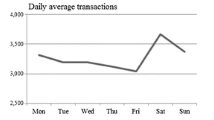Abstract
We address a multi-category workforce planning problem for functional areas located at different service centres, each having office-space and recruitment capacity constraints, and facing fluctuating and uncertain workforce demand. A deterministic model is initially developed to deal with workforce fluctuations based on an expected demand profile over the horizon. To hedge against the demand uncertainty, we also propose a two-stage stochastic program, in which the first stage makes personnel recruiting and allocation decisions, while the second stage reassigns workforce demand among all units. A Benders’ decomposition-based algorithm is designed to solve this two-stage stochastic mixed-integer program. Computational results based on some practical numerical experiments are presented to provide insights on applying the deterministic versus the stochastic programming approach, and to demonstrate the efficacy of the proposed algorithm as compared with directly solving the model using its deterministic equivalent.
Similar content being viewed by others
References
Abernathy WJ, Nicholas B, Hershey JC and Wandel S (1973). A three-stage manpower planning and scheduling model–A service-sector example. Opns Res 21: 693–711.
Bartholomew DJ (1982). Stochastic Models for Social Processes, 3rd edn. John Wiley: Chichester, England.
Bartholomew DJ and Forbes AF (1979). Statistical Techniques for Manpower Planning. Wiley: New York, NY.
Benders JF (1962). Partitioning procedures for solving mixed-variables programming problems. Numer Math 4: 238–252.
Birge JR and Louveaux F (1997). Introduction to Stochastic Programming. Springer-Verlag: New York, NY.
Carøe CC and Schultz R (1999). Dual decomposition in stochastic integer programming. Opns Res Lett 24(1–2): 37–45.
Charnes A, Cooper WW, Lewis KA and Niehaus RJ (1976). A multi-objective model for planning equal employment opportunities. In: Zeleny M. (ed). Multiple Criteria Decision Making, Kyoto, 1975. Springer-Verlag: Berlin, Germany, pp. 111–134.
Charnes A, Cooper WW, Niehaus RJ and Sholtz D (1974). Multi-level models for career management and resource planning. In: Clough D.J., Lewis C.G. and Oliver A.L. (eds). Manpower Planning Models. English University Press: London, England, pp. 91–112.
Corominas A, Ojeda J and Pastor R (2005). Multi-objective allocation of multi-function workers with lower bounded capacity. J Opl Res Soc 56: 738–743.
Edwards JS and Morgan RW (1982). Optimal control models in manpower planning. In: Tzafestas S.G. (ed). Optimization and Control of Dynamic Operational Research Models. North-Holland Publishing Company: Amsterdam, The Netherlands, pp. 143–175.
El Agizy M (1971). A stochastic programming model for manpower planning. In: Bartholomew D.J. and Smith A.R. (eds). Manpower and Management Science. The English Universities Press Ltd: London, England, pp. 131–146.
Georgiou AC and Tsantas N (2002). Modelling recruitment training in mathematical human resource planning. Appl Stochas Models Bus Ind 18: 53–74.
Grinold RC and Marshall KT (1977). Manpower Planning Models. North-Holland Publishing Company: New York, NY.
Kall P and Wallace S (1994). Stochastic Programming. Wiley: Chichester, England.
Lasdon LS (2002). Optimization Theory for Large Systems. Dover Publications: Mineola, NY.
Martel A and Price WL (1977). A normative model for manpower planning under risk. In: Bryant D. and Niehaus R.J. (eds). Manpower Planning and Organizational Design. Plenum: New York, NY, pp. 291–305.
McClean S (1991). Manpower-planning models and their estimation. Eur J Opl Res 51: 179–187.
Mehlmann A (1980). An approach to optimal recruitment and transition strategies for manpower systems using dynamic-programming. J Opl Res Soc 31: 1009–1015.
Morgan RW (1979). Some models for a hierarchical manpower system. J Opl Res Soc 30: 727–736.
Price WL and Piskor WG (1972). The application of goal programming to manpower planning. INFOR 10: 221–231.
Price WL, Martel A and Lewis KA (1980). A review of mathematical-models in human-resource planning. OMEGA 8: 639–645.
Purkiss C (1981). Corporate manpower-planning—A review of models. Eur J Opl Res 8: 315–323.
Sen S and Higle JL (2005). The C 3 theorem and a D 2 algorithm for large scale stochastic mixed-integer programming: set convexification. Math Program 104: 1–20.
Sen S and Sherali HD (2006). Decomposition with branch-and-cut approaches for two stage stochastic mixed-integer programming. Math Program 106: 203–223.
Sherali HD and Fraticelli BMP (2002). A modification of Benders' decomposition algorithm for discrete subproblems: An approach for stochastic programs with integer recourse. J Global Optim 22: 319–342.
Sherali HD and Zhu X (2005). On solving discrete two-stage stochastic programs having mixed-integer first- and second-stage variables. Math Program 108: 597–616.
Sherali HD and Zhu X (2007). Two-stage stochastic mixed-integer programs: algorithms and insights. In Gao DY and Sherali HD (eds). Advances in Mechanics and Mathematics, Vol III. Springer: Berlin, to appear.
Sipper D and Bulfin R (1997). Production: Planning, Control and Integration. McGraw-Hill College: New York, NY.
Ugwuowo FI and McClean SI (2000). Modelling heterogeneity in a manpower system: a review. Appl Stochast Models Bus Ind 16: 99–110.
Yadavalli VSS and Natarajan R (2001). A semi-Markov model of a manpower system. Stochast Anal Appl 19: 1077–1086.
Acknowledgements
This research is supported by the National Science Foundation under Grant Number DMI-0552676.
Author information
Authors and Affiliations
Corresponding author
Rights and permissions
About this article
Cite this article
Zhu, X., Sherali, H. Two-stage workforce planning under demand fluctuations and uncertainty. J Oper Res Soc 60, 94–103 (2009). https://doi.org/10.1057/palgrave.jors.2602522
Received:
Accepted:
Published:
Issue Date:
DOI: https://doi.org/10.1057/palgrave.jors.2602522




